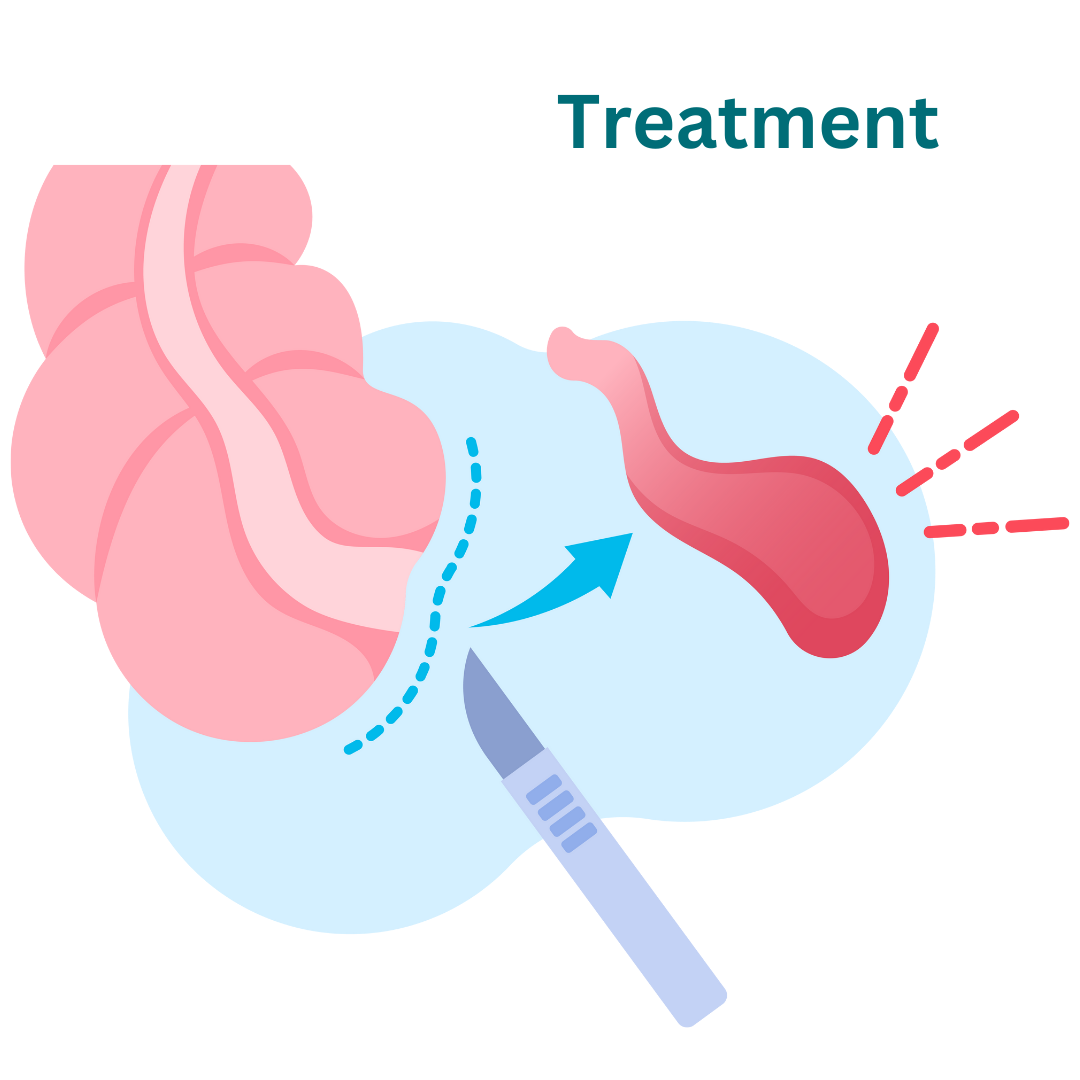Appendix
We specialize in comprehensive treatment solutions for appendix-related conditions.

Causes of Appendicitis:
General causes of Appendicitis:
Appendicitis, the inflammation of the appendix, can be triggered by various factors. Understanding these causes is crucial for timely diagnosis and effective treatment.
1. Obstruction: Blockage of the appendix, often by fecal matter, foreign bodies, or enlarged lymphoid tissue, can lead to inflammation and subsequent appendicitis.
2. Infection: Bacterial infection of the appendix, commonly arising from gastrointestinal infections or bacterial overgrowth, can result in inflammation and swelling.
3. Lymphoid Hyperplasia: Enlargement of lymphoid tissue in the appendix, particularly common in young adults, can predispose individuals to appendicitis by obstructing the lumen and causing inflammation.
4. Gastrointestinal Conditions: Inflammatory bowel disease (IBD), such as Crohn’s disease, and gastrointestinal infections can increase the risk of appendicitis by causing inflammation and disrupting normal appendix function.
5. Genetic Factors: Certain genetic predispositions may play a role in susceptibility to appendicitis, although the specific mechanisms are not fully understood.
6. Dietary Habits: Low-fiber diets have been associated with a higher risk of appendicitis, as they may contribute to fecal impaction and obstruction of the appendix.
By identifying these underlying causes, healthcare providers can better diagnose and manage appendicitis, ensuring appropriate treatment and reducing the risk of complications.
.
Plan For Your Visit
Identification
Bring ID for registration and verification.
Recent Lab Results
Bring recent lab results for evaluation.
Questions
Prepare questions for your consultation.
Symptoms of Appendicitis:
Appendicitis often presents with distinct symptoms, indicating inflammation of the appendix and requiring prompt medical evaluation.
1. Abdominal Pain: The most common symptom of appendicitis is abdominal pain that typically starts around the navel and migrates to the lower right abdomen. The pain may become severe and persistent over time.
2. Loss of Appetite: Individuals with appendicitis may experience a decreased appetite or aversion to eating due to abdominal discomfort.
3. Nausea and Vomiting: Nausea and vomiting are common accompanying symptoms of appendicitis, often occurring after the onset of abdominal pain.
4. Low-Grade Fever: A mild fever may develop in response to the inflammatory process associated with appendicitis.
5. Abdominal Tenderness: Palpation of the abdomen, particularly in the lower right quadrant, may elicit tenderness or discomfort.
6. Localized Rebound Tenderness: Applying pressure to the abdomen and then releasing it (rebound tenderness) may worsen the pain, indicating peritoneal irritation and inflammation.
7. Change in Bowel Habits: Some individuals may experience changes in bowel habits, such as diarrhea or constipation, although this symptom is less common.
8. Malaise: General feelings of fatigue, weakness, or malaise may accompany other symptoms of appendicitis.
It’s essential to seek medical attention promptly if you experience symptoms suggestive of appendicitis, as untreated appendicitis can lead to complications such as perforation and peritonitis.
Diagnosis of Appendicitis:
Diagnosing appendicitis typically involves a combination of medical history review, physical examination, and diagnostic tests to confirm the presence of inflammation and assess the severity of the condition.
1. Medical History and Physical Examination: The healthcare provider will inquire about the onset and progression of symptoms, focusing on abdominal pain, nausea, vomiting, and changes in bowel habits. A thorough physical examination, including assessment of abdominal tenderness and rebound tenderness, is performed to evaluate for signs of appendicitis.
2. Laboratory Tests: Blood tests, including a complete blood count (CBC) and inflammatory markers such as C-reactive protein (CRP) and white blood cell count (WBC), may be ordered to assess for signs of infection or inflammation.
3. Imaging Studies:
– Ultrasound: Ultrasound imaging of the abdomen may be performed to visualize the appendix and assess for signs of inflammation, such as thickening or fluid accumulation around the appendix.
– CT Scan: Computed tomography (CT) scan of the abdomen and pelvis is often considered the gold standard for diagnosing appendicitis. It provides detailed images of the appendix and surrounding structures, aiding in the detection of inflammation, obstruction, or abscess formation.
4. Clinical Scoring Systems: Various clinical scoring systems, such as the Alvarado score or the Pediatric Appendicitis Score (PAS), may be used to assess the likelihood of appendicitis based on symptoms, physical examination findings, and laboratory results.
5. Diagnostic Laparoscopy: In cases where the diagnosis remains uncertain despite other tests, diagnostic laparoscopy, a minimally invasive surgical procedure, may be performed to directly visualize the appendix and confirm the presence of appendicitis.
By combining these diagnostic approaches, healthcare providers can accurately diagnose appendicitis, assess the severity of the condition, and determine the most appropriate treatment approach, whether it involves medical management or surgical intervention. Early diagnosis is crucial for preventing complications associated with appendicitis, such as perforation and peritonitis.

Treatment of Appendicitis:
Treatment for appendicitis typically involves surgical removal of the inflamed appendix, known as an appendectomy. However, the specific approach to treatment may vary depending on the severity of the condition and individual patient factors.
1. Appendectomy: The standard treatment for appendicitis is surgical removal of the inflamed appendix, known as an appendectomy. This procedure can be performed using either open surgery or laparoscopic techniques. Laparoscopic appendectomy, which involves making small incisions and using a camera and specialized instruments to remove the appendix, is associated with less postoperative pain and quicker recovery times compared to open surgery.
2. Antibiotic Therapy: In some cases, particularly those with uncomplicated appendicitis or when surgery is delayed, antibiotic therapy may be initiated to reduce inflammation and infection. Antibiotics may also be used preoperatively to minimize the risk of surgical site infections.
3. Observation and Conservative Management: In select cases of uncomplicated appendicitis, particularly in patients with mild symptoms or when surgery is not immediately feasible, observation and conservative management may be considered. This approach involves close monitoring of symptoms and administration of antibiotics to manage inflammation and infection. However, it’s essential to monitor patients closely for signs of worsening symptoms or complications, as surgical intervention may ultimately be required.
4. Pain Management: Pain management is an integral part of appendicitis treatment, particularly before and after surgery. Nonsteroidal anti-inflammatory drugs (NSAIDs) and opioid medications may be prescribed to alleviate pain and discomfort associated with appendicitis.
5. Fluids and Nutrition: Intravenous fluids may be administered to maintain hydration, particularly in cases of nausea, vomiting, or inability to tolerate oral intake. Once bowel function resumes, a gradual return to a normal diet is encouraged to promote recovery.
We’re Here Whenever You Need Us
Phone
+91-96177 41852
Open Hours
Mon & Fri: 09AM – 11 PM
Mon To Sat: 06PM – 08PM
Miracles Apollo Cradle Hospital
Vatika India Next, Plot No. 45, Sector 82, Gurugram, Haryana 122004
